The Generator Sales Market is estimated to be valued at USD 35.9 billion in 2025 and is projected to reach USD 61.9 billion by 2035, registering a compound annual growth rate (CAGR) of 5.6% over the forecast period.
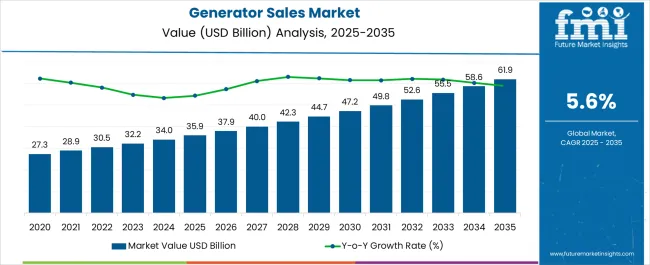
| Metric | Value |
|---|---|
| Generator Sales Market Estimated Value in (2025 E) | USD 35.9 billion |
| Generator Sales Market Forecast Value in (2035 F) | USD 61.9 billion |
| Forecast CAGR (2025 to 2035) | 5.6% |
The generator sales market is expanding steadily due to increasing demand for reliable backup power solutions across industrial, commercial, and residential sectors. Frequent power outages, rising energy consumption, and growing infrastructure development have amplified the reliance on generator systems.
Natural gas and diesel fueled units are witnessing strong demand due to their operational efficiency and ability to support critical facilities. Regulatory emphasis on clean energy solutions is further encouraging the adoption of natural gas powered generators, while technological advancements are improving fuel efficiency and emissions control.
Stationary units are being deployed widely across manufacturing plants, healthcare facilities, and data centers, where uninterrupted power is essential. The outlook remains positive as electrification initiatives, urbanization trends, and smart grid integration continue to reinforce the requirement for dependable power generation assets across diverse applications.
The market is segmented by Fuel Type, Design, Power Rating, Application, Sales Channel, and End User and region. By Fuel Type, the market is divided into Natural Gas, Diesel, and Others. In terms of Design, the market is classified into Stationary and Portable. Based on Power Rating, the market is segmented into Up to 50 kW, Up to 10 kW, 11 to 20 kW, 21 to 30 kW, 31 to 40 kW, 41 to 50 kW, 51 to 280 kW, 281 to 500 kW, 50 to 2,000 kW, 2,001 to 3,500 kW, and Above 3,500 kW. By Application, the market is divided into Prime & Continuous Load, Standby, and Peak Shaving. By Sales Channel, the market is segmented into Direct and Indirect. By End User, the market is segmented into Industrial, Utilities/Power Generation, Oil & Gas, Chemicals & Petrochemicals, Manufacturing, Marine, Commercial, Mining & Metals, Construction, Residential, Healthcare, IT & Telecom, Data Centers, and Others. Regionally, the market is classified into North America, Latin America, Western Europe, Eastern Europe, Balkan & Baltic Countries, Russia & Belarus, Central Asia, East Asia, South Asia & Pacific, and the Middle East & Africa.
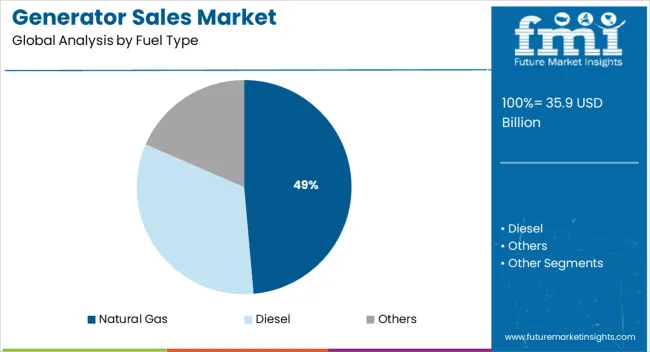
The natural gas segment is projected to account for 48.60% of the total revenue by 2025 within the fuel type category, making it the leading segment. This growth is being supported by increasing regulatory preference for cleaner fuel alternatives, cost efficiency in operations, and abundant gas supply in several regions.
Natural gas powered generators also offer reduced emissions compared to diesel, aligning with sustainability targets across industries. Additionally, low maintenance requirements and compatibility with continuous power applications are enhancing their adoption.
Growing investments in gas infrastructure and rising demand for environmentally sustainable solutions are further consolidating the position of natural gas as the dominant fuel type in the generator sales market.
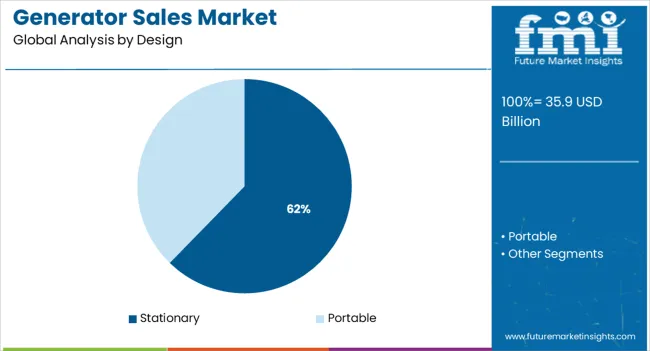
The stationary design segment is expected to hold 62.30% of the total revenue by 2025, positioning it as the most significant design type. This dominance is attributed to widespread installation across critical sectors where uninterrupted power supply is non negotiable, including hospitals, industrial facilities, and data centers.
Stationary units are valued for their durability, higher power capacity, and ability to support long duration operations. Their integration with advanced control systems and compatibility with multiple fuel types has also strengthened their presence in the market.
As businesses and institutions prioritize resilience and operational continuity, stationary designs continue to lead in terms of adoption and revenue generation.
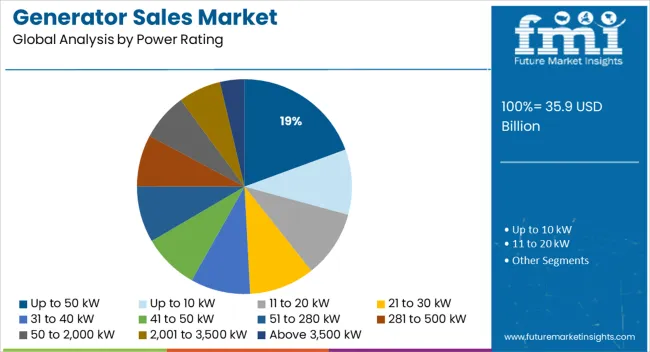
The up to 50 kW segment is anticipated to represent 19.40% of the total revenue by 2025 within the power rating category. This share is driven by increasing adoption across residential complexes, small commercial establishments, and rural electrification projects.
Generators in this range are recognized for their compact size, portability, and cost effectiveness, making them suitable for backup power in areas with frequent outages. Additionally, the rising penetration of renewable energy systems in hybrid models has supported demand for smaller capacity units as supplementary power solutions.
With affordability and accessibility driving consumer choices, the up to 50 kW category maintains its position as a key contributor within the overall generator sales market.
According to a Future Market Insights analysis, the global generator sales forum has risen substantially in recent years. The market's leading rivals are collaborating to fulfill increased demand for generator sales. The CAGR was 5.1% from 2020 to 2025, and it is expected to climb to 5.6% over the forecast period.
Rapid industrialization and urbanization have resulted in greater consumption. This predicament has compelled companies and individuals to cease depending only on power networks, and instead invest in generators to ensure continuous power supply. Power consumption has risen sharply in both emerging and established nations in recent years. Furthermore, rising investments in the extraction of hydrocarbons from reserves have benefited the global market.
For instance, according to the BP Statistical Review of World Energy 2025, global primary energy consumption in 2024 reached 595.15 exajoules, up from 564.01 exajoules in 2024, representing a 5.8% increase year over year.
The industry is fragmented into gas, diesel, and other fuel types based on fuel type.
Due to its dependable operations, considerably high efficiency, reduced maintenance costs, high load operations, and other reasons, the diesel segment is expected to account for the leading generator sales market share globally.
The rise of gas-based generating units is expected to be aided by fewer emissions of hazardous gases, such as nitrogen and sulfur, and more cost-effective operations.
Gensets that run on fuel oil, gasoline, wood gas, and biofuel are included in the others category. Their poor efficiency has hampered their expansion, but rising consumer awareness of environmental issues is expected to drive demand in the forecast term.
The market is divided into three categories based on application: peak load, continuous load, and standby. The continuous load segment demand is likely to be fueled by increased use in heavy-duty applications.
The demand for robust backup power units to withstand abrupt blackouts or power shortages is fueling the standby segment's growth.
Owing to the expanding establishment of high-power applications in remote locations without grid access, the continuous category is expected to have a large generator sales market share in the worldwide market.
The market is categorized based on end-user: industrial, commercial, and residential. The industrial sector accounted for the biggest proportion of the market.
The expansion in the number of industries and the increased usage of generators in industrial applications can be attributed to the causes.
In addition, favorable government policies supporting the development of energy infrastructure have aided businesses in increasing the rate of generator adoption.
Rapid industrialization and rising construction expenditure are expected to boost the market growth. Growing investments in constructing new sophisticated industrial sector establishments and upgrading existing ones are likely to propel the generator sales market forward.
Additionally, the demand for generator sales is boosted by rising national building investment in energy-efficient infrastructure. For example, the United States Census Bureau stated in August 2024 that investment in public buildings in the United States was USD 34 billion in June 2024, up from USD 27.3 billion in 2020.
This is projected to boost power equipment sales. Exploration and production of oil and gas are increasing, which is likely to help the economy grow. Power consumption is steadily increasing in both developed and emerging countries.
Clean energy adoption is increasing, which might stifle market growth. Clean energy deployment objectives set by several regional governments and organizations to reduce greenhouse gas emissions might hinder market growth.
Different countries are required to follow strict regulations to incorporate low-carbon generation technology and reduce their carbon footprint. This might limit the potential for generator installation throughout the world.
Furthermore, increasing expenditures to modernize grid infrastructure and enhance transmission and distribution (T&D) lines may cause certain product acceptance issues.
| Country | United States |
|---|---|
| CAGR (2025 to 2035) | 4.5% |
| HCAGR (2020 to 2025) | 4.2% |
| Country | United Kingdom |
|---|---|
| CAGR (2025 to 2035) | 4.6% |
| HCAGR (2020 to 2025) | 5.2% |
| Country | China |
|---|---|
| CAGR (2025 to 2035) | 5.2% |
| HCAGR (2020 to 2025) | 6% |
| Country | Japan |
|---|---|
| CAGR (2025 to 2035) | 4.9% |
| HCAGR (2020 to 2025) | 5.6% |
| Country | India |
|---|---|
| CAGR (2025 to 2035) | 5% |
| HCAGR (2020 to 2025) | 5.9% |
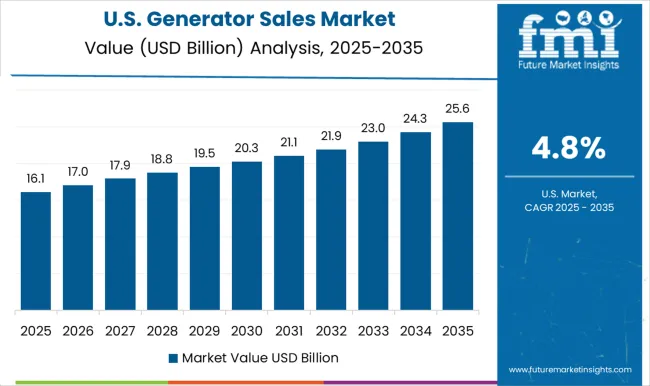
| Attributes | Details |
|---|---|
| United States Market Size (2035) | USD 6.2 billion |
| United States Market Absolute Dollar Growth (USD million/billion) | USD 2.2 billion |
The United States generator sales market is significant, accounting for 4.5% of total North American sales. The United States generator sales market is predicted to reach a high of USD 6.2 billion. Unexpected power outages have raised customer demand for dependable backup power sources in the residential and commercial sectors, boosting the generator sales industry in the United States. Furthermore, the capacity to remain operational across industrial infrastructures without grid power sources has pushed users to implement a variety of techniques to combat blackout scenarios.
In the United States, key players are willing to install, maintain, and service household and commercial generators. These businesses are eager to represent power solutions that are industry leaders in innovative standby power systems. Furthermore, they have the most advanced power management smart technology available today. Key players refit or enhance the customer's power generation to meet their exact specifications. They also have in-house generator servicing professionals to ensure that the generators are always ready when the customer needs them.
Rapid development and urbanization have increased the demand for continuous electric power. As a result, power backups have become an essential component of growth. Fully licensed, bonded, and insured electricians from key companies are available to do a load estimate on electrical service consumption at the end user's home or company. Moreover, they can source a new backup or standby generator for the customer that meets the criteria. They can even create concrete pads for a new generator.
According to the United States Energy Information Administration, energy output and consumption in the United States increased by about 6% in 2020. As a result, the United States has made significant investments in the exploration and production of natural gas and crude oil from both onshore and offshore regions. In addition, several companies are implementing biofuel generators to reduce carbon emissions and operating expenses. This element is projected to generate an opportunity for generator sales companies in the United States market.
| Attributes | Details |
|---|---|
| United Kingdom Market Size (2035) | USD 1.3 billion |
| United Kingdom Market Absolute Dollar Growth (USD million/billion) | USD 481.5 million |
The United Kingdom is a significant generator sales market, with an estimated value of USD 1.3 billion and a 4.6% revenue growth rate throughout the forecast period. Key businesses in the country provide generators suitable for a wide variety of recreational and professional applications. Camping, sailing, building, and small company applications are among them. Additionally, the solely United Kingdom-based design, fabrication, and manufacturing process imply that clients receive unrivaled product quality and support services.
Key players in the United Kingdom sell a wide choice of diesel generator ranges ranging from 67Kw to 67Kw. They are professionally developed to provide customers with a stress-free experience. As a result, they may avoid having to tolerate significant amounts of noise while the generator is running. The goal of leading participants is to deliver easy, well-informed, and trouble-free solutions for emergency and prime power needs. Certain significant players have authorized generator dealers. These generators are manufactured by well-known industry firms and are designed to give a stable power source.
English consumers prefer brand-new generators, since they come with a complete warranty. This implies that if any unexpected issues develop, the manufacturer is expected to address them for free. With a warranty, the consumer is not liable for any unanticipated difficulties. Second-hand or reconditioned generators may also come with a warranty in some situations. However, these are likely to have a shorter lifespan than brand-new generators.
Purchasing a second-hand generator does not have to be a gamble. Certain market participants offer used generators and are dedicated to supplying just the best-used diesel generators. They also say that all used generators they offer go through a 75-point service inspection and a complete load test before being dispatched. Furthermore, all of their service experts are highly experienced and well-versed in all of the typical difficulties related to diesel and gasoline power generation. They are eager to install equipment fast and monitor performance to provide ongoing, dependable service.
| Attributes | Details |
|---|---|
| China Market Size (2035) | USD 4.2 billion |
| China Market Absolute Dollar Growth (USD million/billion) | USD 1.7 billion |
China currently dominates the generator sales market, accounting for 5.2% of total sales. The Chinese generator sales market is valued at USD 4.2 billion. This is attributed to increased infrastructure projects, a widening power demand-supply mismatch, manufacturing facility development, and burgeoning commercial office space across the country. The country benefits from the low cost and high efficiency of diesel generators, while rising living standards increase demand for power backup equipment.
Key businesses concentrate on producing intelligent generator sets, intending to supply superior intelligent generator sets. This is done to support ‘Made in China’ products and the application of the 'innovation-driven development' strategy. Additionally, they are prepared to provide the world's consumers with the most effective, complete, and timely intelligent cloud hybrid energy solution.
The industrial sector held the strongest market share for diesel generators in China in 2020. This is attributed to the industrial sector's growing need for a consistent and dependable power supply. In addition, the development of hybrid power solutions, which combine diesel generators with renewable energy sources like solar PV, is anticipated to open up a lot of potential for market players soon.
Generators are made scientifically from just raw materials and come in enhanced designs and a wider variety. These are easily accessible in a range of designs and specifications based on the preferences of the consumer. Prominent companies provide both generic and specialized generator set solutions. Through their foreign dealers and distributors, this is particularly feasible. Additionally, they strive to provide premium quality manufacturing with excellent company ideas, honest product sales, and top-notch, prompt customer service.
| Attributes | Details |
|---|---|
| India Market Size (2035) | USD 1.1 billion |
| India Market Absolute Dollar Growth (USD million/billion) | USD 415.8 million |
With a revenue growth rate of 5% and a predicted value of USD 1.1 billion over the projection year, India is a very profitable generator sales market. Technological improvements in generators are projected to significantly influence the Indian industry. Owing to constant technological breakthroughs, diesel generators are the most popular in the country and have a substantial share among other fuel-based generators.
Generators offered by key players function exceptionally silently owing to breakthrough technologies. Every element has been considered when creating its features to make it a full standby power supply. Significant partnerships, technological know-how assistance, and licensing agreements with chosen industry behemoths have enabled market participants to achieve unprecedented growth. Furthermore, they are renowned to employ high-quality engines from reputable suppliers.
The power supply that is uninterruptible and dependable, as well as the widespread use of DG (diesel generator), sets in healthcare and the IT industry, are responsible for the market's growth. In India, popular generators are outfitted with four-stroke liquid-cooled gas engines and Common Rail Direct Injection (CRDi) technology. These are created mostly in collaboration with other machine and engine manufacturers.
In terms of several characteristics, such as noise and emission, generators available in the nation conform with notices and recommendations published by the Central Pollution Control Board (CPCB). Manufacturers invest considerably in the establishment of cutting-edge facilities for the manufacturing of high-quality generators. Recently, businesses have expressed interest in developing hybrid generators that use both solar and fuel energy. Moreover, several key businesses provide diesel generators at more inexpensive pricing to the general public.
Start-up companies are supplying accessories or other solutions, or products based on generators. This is expected to drive the global generator sales market growth:
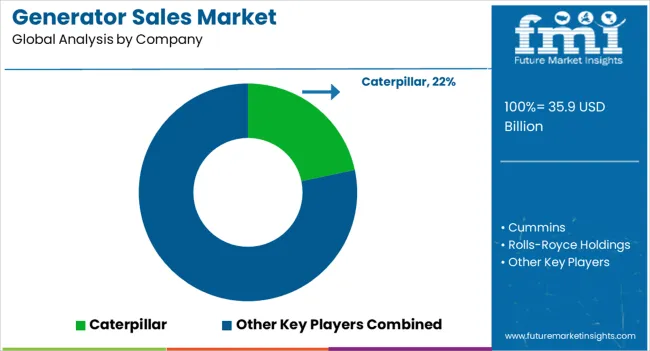
The generator sales market share is very competitive due to the existence of multiple well-established rivals. To capitalize on market growth opportunities, these companies are concentrating on expanding their reach through acquisitions, expansions, product approvals, and launches.
Recent Developments:
Top Market Players in the Market:
The global generator sales market is estimated to be valued at USD 35.9 billion in 2025.
The market size for the generator sales market is projected to reach USD 61.9 billion by 2035.
The generator sales market is expected to grow at a 5.6% CAGR between 2025 and 2035.
The key product types in generator sales market are natural gas, diesel and others.
In terms of design, stationary segment to command 62.3% share in the generator sales market in 2025.






Full Research Suite comprises of:
Market outlook & trends analysis
Interviews & case studies
Strategic recommendations
Vendor profiles & capabilities analysis
5-year forecasts
8 regions and 60+ country-level data splits
Market segment data splits
12 months of continuous data updates
DELIVERED AS:
PDF EXCEL ONLINE
Generator Sets Market Size and Share Forecast Outlook 2025 to 2035
Gas Generator Sets Market Growth - Trends & Forecast 2025 to 2035
Hydrogenerators Market
Power Generator for Military Market Size and Share Forecast Outlook 2025 to 2035
Motor Generator Set Market Size, Growth, and Forecast 2025 to 2035
Pulse Generator Market
Ozone Generators Market
Hybrid Generator Sets Market Size and Share Forecast Outlook 2025 to 2035
Signal Generator Market Analysis by Product, Technology, Application, End-use, and Region through 2035
Silent Generator Market Analysis by Sound Level, Type, Phase, Power Rating, Fuel, Application, End User, and Region through 2035
Standby Generator Sets Market Size and Share Forecast Outlook 2025 to 2035
Telecom Generator Market Size and Share Forecast Outlook 2025 to 2035
Railway Generators Market Growth - Trends & Forecast 2025 to 2035
Hydrogen Generator Market Size and Share Forecast Outlook 2025 to 2035
Surgical Generators Market – Trends & Forecast 2025 to 2035
Aircraft Generators Market Trends and Forecast 2025 to 2035
Gasoline Generator Market - Growth & Demand 2025 to 2035
PLL Clock Generator Market Size and Share Forecast Outlook 2025 to 2035
RF Plasma Generators Market
Electrical Generators Market

Thank you!
You will receive an email from our Business Development Manager. Please be sure to check your SPAM/JUNK folder too.
Chat With
MaRIA